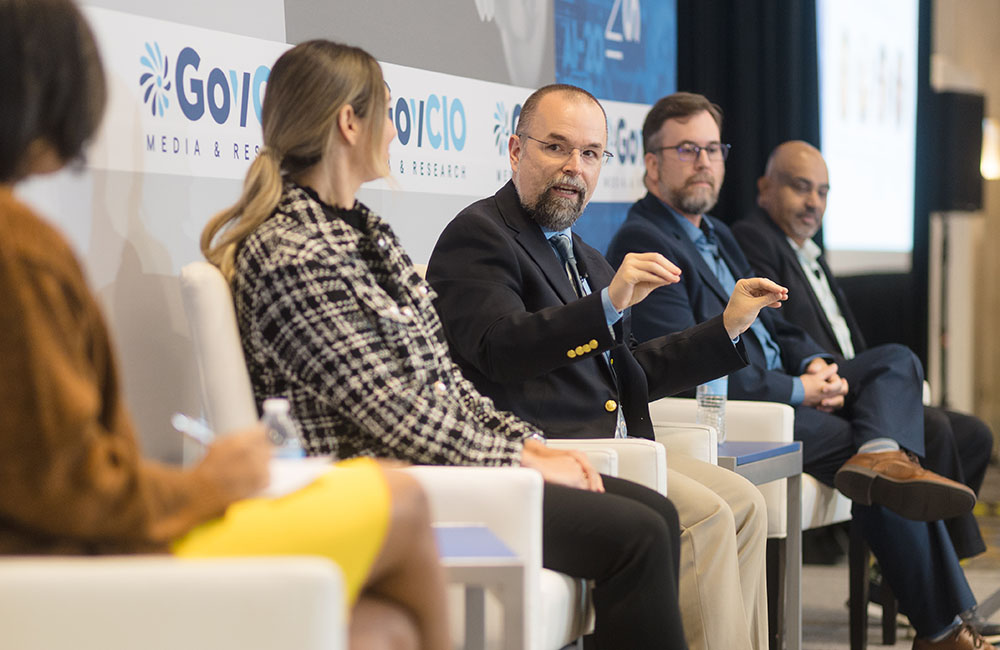CMS, CISA Tackling Cybersecure Services
Customer-facing services like the CMS provide unique cybersecurity challenges, but the White House’s Office of the National Cyber Director is providing new funding assistance.

The White House’s recently established Office of the National Cyber Director will work with agencies to help them prioritize and apply Technology Modernization Fund (TMF) funding to high-value assets and external facing services such as health care. The office will also help agencies secure additional funding.
“I feel like the creation of that office, in combination with EO14028 [on improving the nation’s cybersecurity], is really going to help in highlighting this issue across all the agencies,” Valerie Cofield, CISA’s chief of strategy, policy and plans, said at GovCIO’s Women Tech Leaders event Thursday. “We’re hoping that spotlighting the budgetary shortfalls that are in these agencies as well as providing a fund to help with some of those gaps should be one step forward in this area.”
Cybersecurity can provide unique challenges at customer-facing agencies like the Centers for Medicare and Medicaid Services. CMS processes millions of user identities and personal private health data across its Medicare, Medicaid and HealthCare.gov marketplace services.
“What we’re working on right now with the implementation of zero trust architecture is taking the executive order and really tailoring it to CMS and tailoring it to some of our needs,” said CMS Digital Services Executive Director Andrea Fletcher at the event.
For example, Medicaid mostly serves people who are below the poverty line, which means that cybersecurity measures have to account for some customers’ limited access to technology.
“Often we’re trying to provide equitable security,” Fletcher said. “We have people who don’t have access to a phone or computer. So, how do we provide two-factor authentication if somebody doesn’t have a phone, right? That’s definitely a huge challenge for us.”
Services like the marketplace, which Americans typically interact with only once a year when they sign up for coverage, also bring about their own challenges when it comes to implementing zero trust principles. Over the course of a year, many people may change their name or address, or they get a new device. CMS has to match those individuals in their systems and make sure they are who they say they are.
CMS was one of the early recipients of the TMF, which provides funding for agencies to modernize their infrastructure and build in security.
“In the American rescue plan, there was a billion dollars that was dedicated to help improve cybersecurity,” Cofield said. “This billion dollars was put into the technology modernization fund, and really the goal of that fund is really to help replace these legacy systems and to modernize and put cybersecurity into the systems. But it’s hard, it’s complicated, and even though a million dollars sounds like a lot, it’s really just a down payment.”
The Office of the National Cyber Director will be working with agencies to help them prioritize TMF funding and also secure new funding, with a focus on high-value assets and external facing services. CISA’s National Risk Management Center works to identify what some of those high-value assets are.
“What we’re doing in our National Risk Management Center is really looking at those critical functions and trying to decompose them so that we can get to what we call our high-value assets and figure out, since we do have limited resources, how we can secure those,” Cofield said.
Cofield said that in the late summer or early fall CISA expects to release its baseline cybersecurity performance goals for the critical infrastructure sectors, which include health care and public health.
“Each sector has its nuances, and there probably will be things that need to be tailored, but we’re starting with a broad approach to raise the standard and the baseline standards across all critical infrastructure,” Cofield said.
This is a carousel with manually rotating slides. Use Next and Previous buttons to navigate or jump to a slide with the slide dots
-

The Next AI Wave Requires Stronger Cyber Defenses, Data Management
IT officials warn of new vulnerabilities posed by AI as agencies continue to leverage the tech to boost operational efficiency.
5m read -

Federal CIOs Push for ROI-Focused Modernization to Advance Mission Goals
CIOs focus on return on investment, data governance and application modernization to drive mission outcomes as agencies adopt new tech tools.
4m read -

DOD Can No Longer Assume Superiority in Digital Warfare, Officials Warn
The DOD must make concerted efforts to address cyber vulnerabilities to maintain the tactical edge, military leaders said at HammerCon 2025.
4m read -

Tracking CIOs in Trump's Second Term
Stay informed on the latest shifts in federal technology leadership as new CIOs are appointed and President Trump's second term takes shape.
6m read -

Inside Oak Ridge National Lab’s Pioneer Approach to AI
Energy Department’s Oak Ridge National Lab transforms AI vulnerabilities into strategic opportunities for national defense.
22m listen -

AWS Summit: Innovation Accelerates IT Delivery at DOD
Marine Corps Community Services is tackling outdated IT processes with agile development and cutting-edge cloud security to deliver mission-critical capabilities faster.
12m watch -

AWS Summit: NIST Secures High-Performance Computing Against Evolving Threats
NIST’s Yang Guo reveals the broad attack surface of high-performance computing and explains developing guidance and future-proofing security strategies.
9m watch -

Trump Overhauls Federal Cybersecurity with New Executive Order
The new directive aims to strengthen digital defenses while rolling back "burdensome" software requirements and refocusing AI security.
3m read -

AWS Summit: Forging Successful Cloud Modernization Partnerships
Industry leaders share insights on the critical role industry partnerships have in enabling government agencies to navigate procurement challenges for cloud and zero trust solutions.
24m watch Partner Content -

CISA's CVE Program and Why it Matters for Zero Trust
The vulnerability program provides the cybersecurity community visibility into software as part of a key pillar of CISA's zero trust model.
5m read -

Air Force, Coast Guard Talk Data Security Efforts for AI Development
The services' AI initiatives include efforts like creating clean training data, countering data poisoning and bridging siloed teams.
4m read -

DHS Secretary Urges Congress to Reauthorize CISA 2015
Federal leaders highlight CISA 2015's role in strengthening public-private partnerships and defending against evolving cyber threats.
3m read




